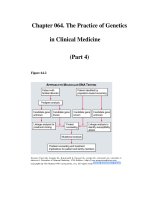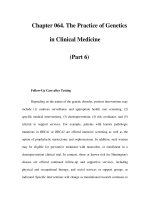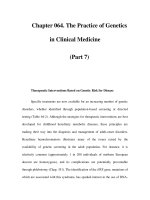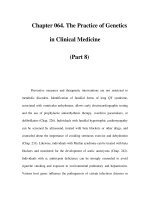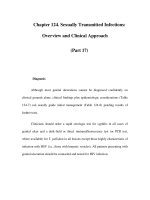Chapter 124. Sexually Transmitted Infections: Overview and Clinical Approach (Part pdf
Bạn đang xem bản rút gọn của tài liệu. Xem và tải ngay bản đầy đủ của tài liệu tại đây (17.61 KB, 5 trang )
Chapter 124. Sexually Transmitted Infections:
Overview and Clinical Approach
(Part 17)
Diagnosis
Although most genital ulcerations cannot be diagnosed confidently on
clinical grounds alone, clinical findings plus epidemiologic considerations (Table
124-7) can usually guide initial management (Table 124-8) pending results of
further tests.
Clinicians should order a rapid serologic test for syphilis in all cases of
genital ulcer and a dark-field or direct immunofluorescence test (or PCR test,
where available) for T. pallidum in all lesions except those highly characteristic of
infection with HSV (i.e., those with herpetic vesicles). All patients presenting with
genital ulceration should be counseled and tested for HIV infection.
Table 124-7 Clinical Features of Genital Ulcers
Feature
Syp
hilis
Herp
es
Cha
ncroid
Lympho
granuloma
Venereum
Don
ovanosis
Incubati
on period
9–
90 days
2–7
days
1–
14
days
3 days–
6
weeks
1–4
weeks (up
to 6
months)
Early
primary lesions
Pap
ule
Vesic
le
Pust
ule
Papule,
pustule, or
vesicle
Papu
le
No. of
lesions
Usu
ally one
Multi
ple
Usua
lly
multiple,
may
Usually
one; often not
detected,
despitelymphad
Vari
able
coalesce enopathy
Diamete
r
5–
15 mm
1–2
mm
Vari
able
2–10 mm
Vari
able
Edges Sha
rply
demarcate
d,
elevated,
round, or
oval
Eryth
ematous
Und
ermined,
ragged,
irregular
Elevated,
round, or oval
Elev
ated,
irregular
Depth Sup
erficial or
deep
Supe
rficial
Exca
vated
Superfici
al or deep
Elev
ated
Base Sm
ooth,
nonpurulen
t, relatively
Sero
us,
erythematou
s,
Puru
lent, blee
ds
easily
Variable,
nonvascular
Red
and velvety,
bleeds
readily
nonvascula
r
nonvascular
Indurati
on
Fir
m
None
Soft Occasion
ally firm
Firm
Pain Unc
ommon
Freq
uently
tender
Usua
lly very
tender
Variable Unco
mmon
Lympha
denopathy
Fir
m,
nontender,
bilateral
Firm,
tender, often
bilateral
with initial
episode
Tend
er, may
suppurate,
loculated,
usually
unilateral
Tender,
may suppurate,
loculated,
usually
unilateral
None
;
pseudobubo
es
Source: From RM Ballard, in KK Holmes et al (eds):
Sexually Transmitted
Diseases, 4th ed. New York, McGraw-Hill, 2008.



